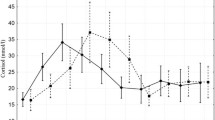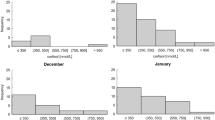Abstract
After a 2 week control period at 400 m, cattle were exposed to 5,000 m simulated altitude for 2 weeks, which was followed by a 2-week post-altitude control period. Plasma cortisol values from blood samples taken every 30 min for a total of 24 h indicated that cortisol was secreted episodically and that a circadian rhythm existed. When cortisol values were grouped into 4, 6-h periods, plasma cortisol was most abundant from 06:00 to 12:00 h with an average of 0.96µ g/100 ml and least abundant from 00:30 to 06:00 h with an average of 0.55µ g/100 ml. Plasma cortisol increased from 0.42 to 3.08µ g/100 ml during the 4 h ascent to 5,000 m and decreased to near normal levels the following day. A rhythmic plasma cortisol pattern was maintained after one day at simulated high altitude.
Similar content being viewed by others
References
BIANCA, W. and ESPINOSA, J.P. (1975): Untersuchungen über die Höhentoleranz von Kälbern. Z. Tierz. Zuchtbiol., 93 in print.
BODDY, K., JONES, C.T., MANTELL, C., RATCLIFFE, J.G. and ROBINSON, J.S. (1974): Changes in plasma ACTH and corticosteroid of the maternal and fetal sheep during hypoxia. Endocrinology, 94: 588–591.
GUILLEMIN, R., DEAR, W.E. and LIEBELT, R.A. (1959): Nachthemeral variation in plasma free corticosteroid levels of the rat. Proc. Soc. exp. Biol. (N.Y.), 101: 394–395.
HECHT, H.H., KUIDA, H., LANGE, R.L., THORNE, J.L. and BROWN, A.M. (1962): Brisket disease. II. Clinical features and hemodynamic observations in altitude-dependent right heart failure of cattle. Amer. J. Med., 32: 171–183.
HEITZMAN, R.J., ADAMS, T.C. and HUNTER, G.D. (1970): The assay of corticosteroids in plasma of the dairy cow. J. Endocr., 47: 133–134.
LAU, C. (1971): Effects of O2-CO2 changes on hypothalamo-hypophyseal adrenocortical activation. Amer. J. Physiol., 221: 607–612.
MACADAM, W.R. and EBERHART, R.T. (1972): Diurnal variation in plasma corticosteroid concentration in dairy cattle. J. Dairy Sci., 55: 1792–1795.
MCNATTY, K.P., CASHMORE, M. and YOUNG, A. (1972): Diurnal variation in plasma cortisol levels in sheep. J. Endocr., 54: 361–362.
MCNATTY, K.P. and THURLEY, D.C. (1973): The episodic nature of changes in ovine plasma cortisol levels and their response to adrenaline during adaptation to a new environment. J. Endocr., 59: 171–180.
MONCLOA, F., DONAYRE, J., SOBREVILLA, L.A. and GUERRA-GARCIA, R. (1965): Endocrine studies at high altitude: II. Adrenal cortical function in sea-level natives exposed to high altitudes (4,300 m) for two weeks. J. clin. Endocr., 25: 1640–1642.
MURPHY, B.E.P., ENGELBERG, W. and PATTEE, C.J. (1963): Simple method for the determination of plasma corticoids. J. clin. Endocr., 23: 293–300.
MYLES, W.S. and DUCKER, A.J. (1973): The role of the sympathetic nervous system during exposure to altitude in rats. Int. J. Biometeor., 17: 51–58.
PATERSON, J.Y.F. and LINZELL, J.L. (1974): Cortisol secretion rate, glucose entry rate and the mammary uptake of cortisol and glucose during pregnancy and lactation in dairy cows. J. Endocr., 62: 371–383.
ROSE, R.M., KREUZ, L.E., HOLADAY, J.W., SULAK, K.J. and JOHNSON, C.E. (1972): Diurnal variation of plasma testosterone and cortisol. J. Endocr., 54: 177–178.
SINGH, I., MALHOTRA, M.S., KHANNA, P.K., NANDA, R.B., PURSHOTTAM, T., UPADHYAY, T.N., RADHAKRISHNAN, U. and BRAHMACHARI, H.D. (1974): Changes in plasma cortisol, blood antidiuretic hormone and urinary catecholamines in high-altitude pulmonary oedema. Int. J. Biometeor., 18: 211–221.
VAN LIERE, E.J. and STICKNEY, J.C. (1963): Hypoxia. University of Chicago Press, Chicago and London.
WAGNER, W.C. and OXENREIDER, S.L. (1972): Adrenal function in the cow: Diurnal changes and the effects of lactation and neurohypophyseal hormones. J. Anim. Sci., 34: 630–635.
WEITZMAN, E.D., FUKUSHIMA, D., NOGEIRE, C., ROFFWARG, H., GALLAGHER, T.F. and HELLMAN, T.F. (1971): Twenty-four hour pattern of the episodic secretion of cortisol in normal subjects. J. clin. Endocr., 33: 14–22.
Author information
Authors and Affiliations
Rights and permissions
About this article
Cite this article
Hays, F.L., Armbruster, H., Vetter, W. et al. Plasma cortisol in cattle: Circadian rhythm and exposure to a simulated high altitude of 5,000 m. Int J Biometeorol 19, 127–135 (1975). https://doi.org/10.1007/BF01463869
Received:
Issue Date:
DOI: https://doi.org/10.1007/BF01463869




